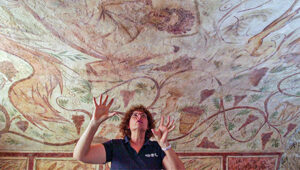Two stunning Roman-era tombs in the ancient coastal city of Ashkelon in southern Israel have undergone painstaking restoration in advance of opening to the public for the first time. The tombs have been incorporated into a single archaeological park just 300 yards from the beach.
Though close in physical proximity, the tombs were discovered more than half a century apart, with one being opened in the 1930s and the other in the 1990s. The older of the two tombs dates to the second century CE, while the later one was in use in the early fourth century.
Open to the public since last October, these beautiful tombs provide visitors with a remarkable visual experience. Both are richly decorated with impressive paintings depicting the Greek goddess Demeter, vines, grape clusters, birds, deer, nymphs, and even the head of Medusa, the mythical gorgon who could turn men into stone with a single look. It is highly unusual for such paintings to be preserved in Israel’s humid climate, but thanks to the enclosed space within the tombs, these have managed to survive.
The conservation of the tombs’ artwork was a major undertaking in itself. According to Mark Abrahami, head of the Israel Antiquities Authority’s conservation unit, “We had to conduct a long and sensitive process to stop and repair the ravages of time and weathering. Some paintings had to be removed from the walls for thorough treatment in [our] conservation laboratories until they were returned to the site.”


